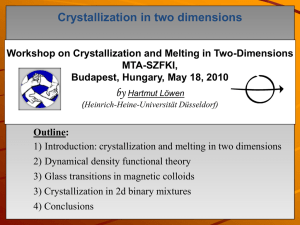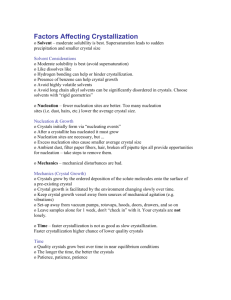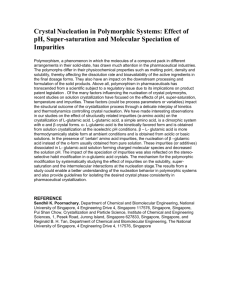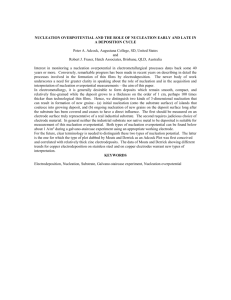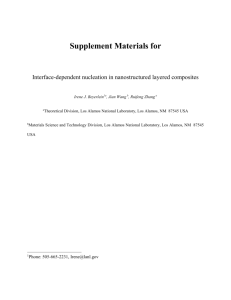Schwarz_Jens-O_Talk - SWISS GEOSCIENCE MEETINGs
advertisement
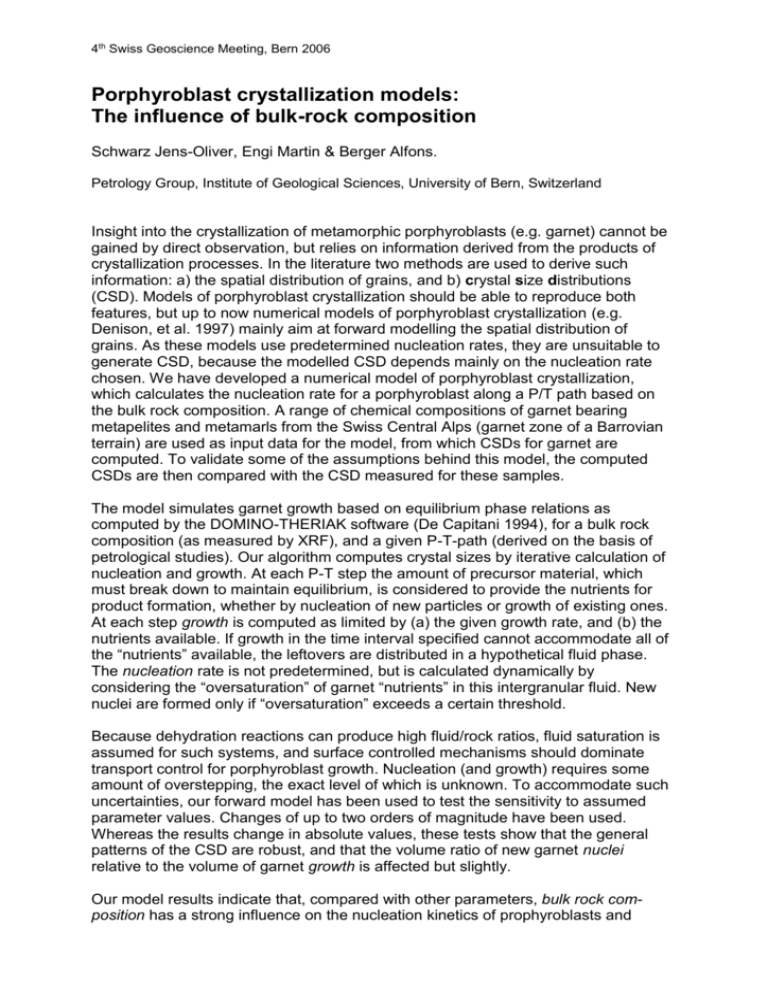
4th Swiss Geoscience Meeting, Bern 2006 Porphyroblast crystallization models: The influence of bulk-rock composition Schwarz Jens-Oliver, Engi Martin & Berger Alfons. Petrology Group, Institute of Geological Sciences, University of Bern, Switzerland Insight into the crystallization of metamorphic porphyroblasts (e.g. garnet) cannot be gained by direct observation, but relies on information derived from the products of crystallization processes. In the literature two methods are used to derive such information: a) the spatial distribution of grains, and b) crystal size distributions (CSD). Models of porphyroblast crystallization should be able to reproduce both features, but up to now numerical models of porphyroblast crystallization (e.g. Denison, et al. 1997) mainly aim at forward modelling the spatial distribution of grains. As these models use predetermined nucleation rates, they are unsuitable to generate CSD, because the modelled CSD depends mainly on the nucleation rate chosen. We have developed a numerical model of porphyroblast crystallization, which calculates the nucleation rate for a porphyroblast along a P/T path based on the bulk rock composition. A range of chemical compositions of garnet bearing metapelites and metamarls from the Swiss Central Alps (garnet zone of a Barrovian terrain) are used as input data for the model, from which CSDs for garnet are computed. To validate some of the assumptions behind this model, the computed CSDs are then compared with the CSD measured for these samples. The model simulates garnet growth based on equilibrium phase relations as computed by the DOMINO-THERIAK software (De Capitani 1994), for a bulk rock composition (as measured by XRF), and a given P-T-path (derived on the basis of petrological studies). Our algorithm computes crystal sizes by iterative calculation of nucleation and growth. At each P-T step the amount of precursor material, which must break down to maintain equilibrium, is considered to provide the nutrients for product formation, whether by nucleation of new particles or growth of existing ones. At each step growth is computed as limited by (a) the given growth rate, and (b) the nutrients available. If growth in the time interval specified cannot accommodate all of the “nutrients” available, the leftovers are distributed in a hypothetical fluid phase. The nucleation rate is not predetermined, but is calculated dynamically by considering the “oversaturation” of garnet “nutrients” in this intergranular fluid. New nuclei are formed only if “oversaturation” exceeds a certain threshold. Because dehydration reactions can produce high fluid/rock ratios, fluid saturation is assumed for such systems, and surface controlled mechanisms should dominate transport control for porphyroblast growth. Nucleation (and growth) requires some amount of overstepping, the exact level of which is unknown. To accommodate such uncertainties, our forward model has been used to test the sensitivity to assumed parameter values. Changes of up to two orders of magnitude have been used. Whereas the results change in absolute values, these tests show that the general patterns of the CSD are robust, and that the volume ratio of new garnet nuclei relative to the volume of garnet growth is affected but slightly. Our model results indicate that, compared with other parameters, bulk rock composition has a strong influence on the nucleation kinetics of prophyroblasts and 4th Swiss Geoscience Meeting, Bern 2006 hence on the CSD patterns. Since our CSD data for natural samples of different bulk composition are comparable with results from our model, we conclude that bulk rock composition has a major influence on garnet crystallization mechanisms. Variations in CSD depend mainly upon nucleation density. The model shows that changes in the nutrient production rate influence the nucleation density, which in turn strongly affects the CSD. Changes in the nutrient production rate may occur not only due to changes in bulk rock composition but also by varying the P/T-path. These results go beyond previous models, which have assumed a specific nucleation density and have interpreted the shape of CSD to be essentially a consequence of the governing growth mechanism. REFERENCES De Capitani C (1994) Gleichgewichts-Phasendiagramme: Theorie und Software. Beihefte zum European Journal of Mineralogy, 72. Jahrestagung der Deutschen Mineralogischen Gesellschaft 6:48 Denison C, Carlson WD, Ketcham RA (1997) Three-dimensional quantitative textural analysis of metamorphic rocks using high-resolution computed X-ray tomography: Part I. Methods and techniques. J. metamorphic Geol. 15:29-44


